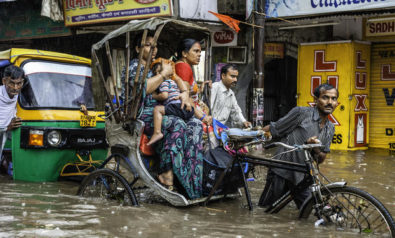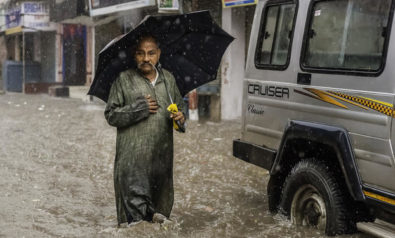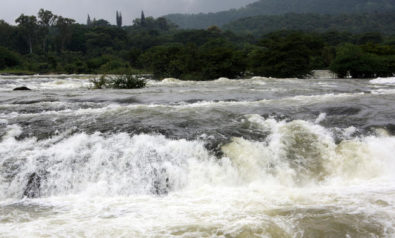The Uttarakhand floods were a direct result of misguided government policy.
The Uttarakhand disaster in India, which struck during the 2013 monsoon season, was a consequence of the disastrous ecological systems upholding the fragile Himalayan ranges. The greed for profit through its rich natural and cultural heritage is a driving factor towards rapacious and unplanned development in the region.
The State of Uttarakhand is the source of the sacred Ganga River, often dubbed as the “Lifeline of India.” The sanctity of the Ganga’s glacial sources and tributaries have been observed since times immemorial; Hindu deities in magnificent temples have been worshipped there. These sites were anointed as sacred in order to protect the Ganga River and the Himalayan range at large. According to legend, the yatra (Hindu pilgrimage/journey) to the four holy sites of Gangotri, Yamunotri, Kedarnath and Badrinath, the Char Dham (the four abodes/seats of Hindu Gods) was meant to enable people to connect culturally, spiritually and ecologically to sources of the rivers of India: the bhutirths (sacred/purest sites of the earth) and, in turn, connect to the sources of all life itself.
The Himalayan Mountains have sustained local communities and pilgrims for thousands of years. This is because, in the past, they have been treated with reverence and respect. Today, however, the situation has changed. The Himalayas are being plundered and pillaged for all to see.
A Complete Failure
The June 2013 flash flood disaster, which caused over 5,000 deaths and disappearances, is a wake-up. We need to revere and respect the sacred mountains and rivers of India as we once did. India is continuing on an unsustainable path of development.
This article is a call to incorporate scientific discoveries into ecological conservation. As the country struggles under the burden of corruption, all that follows after a disaster of such intensity is a saga of mud-slinging. Everyone blames the other while no one gets the job done. Thus, contrary to what the politicians of Uttarakhand say, the disaster was clearly manmade. It is the politicians, decision-makers and corporations who are responsible for causing the disaster through shortsightedness, ignorance, and greed. They need to take responsibility for the disaster as a direct result of their policies. The Polluter Pays Principle, a universally accepted principle of international law, must be expanded to cover the scale of ecological devastation that has been witnessed.
On June 25, the chief minister of Uttarakhand, Vijay Bahuguna, stated that the Himalayan disaster set back Uttarakhand by three years and damaged development projects worth Rs 3000 crore (Rs 30 billion). This is evidence that Bahuguna only looks at development in terms of profit. He fails to see that the formation of an inch-thick layer of protective top-soil, which was washed away, will take another 500 years to develop. He fails to see that local communities over thousands of years have worked hard to coexist peacefully with the fragile mountains. He fails to see the millions of years it took the Himalayas to form. He fails to see that the devastation caused by the floods to the lives and livelihoods of local communities cannot possibly be reversed in three years.
In 1916, Rai Patiram Bahadur, in his book “Garhwal: Ancient and Modern,” wrote:
“We may say that there is no country in the world of the dimension of Garhwal which has so many rivers as a traveler will find in this land. The district has 60 rivers of different sizes; besides these, there are rivulets, rills, springs and fountains in hundreds, showing that nature has been especially bountiful to this land in the matter of its water supply.”
Dynamite and Dams
Today, the Garhwal region and other parts of Uttarakhand are being violated, as rivers are dammed and diverted for electricity, and the pilgrimage to the Char Dhams is turned into a crass consumerist tourism routine. It is evident that the Himalayan landscape has undergone a drastic change for the worse over a century.
An RTI query, filed by activists in 2010, revealed that the state government planned to construct 557 dams across the River Ganga and its tributaries. Next to the Narmada Bachao Andolan, which threw light on India’s unfounded obsession to dam Indian rivers, the biggest agitation has been against the Tehri dam. This is the tallest dam in the world, located on the river Bhagirathi. Its first phase was completed in 2006, despite intense opposition. There are hundreds of dams on rivers like Bhagirathi, Alaknanda, Mandakini, Gauriganga, which are either built, or about to be built and are running "bumper-to-bumper." Often a "shortcut" is created by blasting tunnels through hill-sides, to create a gravity induced water flow. It plays absolute mayhem with the ecology, the flora and fauna, and the local people's livelihoods. The long-term impact of such hydel projects is unknown, as environment costs of any project are never taken into consideration.
The pioneering Swami Gyanswarup Sanand, (formerly Dr. G.D. Agrawal) of the Ganga Sewa Abhiyanam (an organization based in Varanasi, India committed to the conservation of the Ganga River) has repeatedly gone on fast to save the Ganga. His efforts forced the Indian government to declare the area from Uttarkashi to Gaumukh an eco-sensitive zone in April this year. The Uttarakhand state government strongly opposed the Indian government's decision to make the declaration. The chief minister then stated that a blanket ban on deforestation and the establishment of factories to manufacture furniture and other wooden items, would not be in the interests of the state.
The disaster of 2013 ought to have made him realize the value of protecting the Himalayan banks of the Ganga River. There is an urgent need to protect the entire catchment region of the Ganga. And it is not just the stretch between Uttarkashi and Gaumukh that is ecologically fragile.
Blasting dynamite recklessly to construct dams and tunnels, triggered thousands of landslides. When the first rain comes, these landslides fill the river bed with rubble, leaving no space for water to flow. These activities end up literally stealing the ecological space required by rivers. Overflow and flooding is a natural consequence when rivers have no space to flow.
Local communities, which are often unseen and unheard in the mainstream media, cannot retrieve their loved ones that extinguished in the disaster, or their fields and homes that were washed away. But those that caused the catastrophe by building dams — the construction companies like JP, GVK, LANCO, L&T, etc — will lose nothing.
It is high time that hydroelectric projects are reassessed. The environmental impact of any project has to be taken into account, and the ecological loss quantified. This is how the cost-benefit ratio of any project will be ascertained. The opinion and approval of local communities, which bear the brunt of development projects’ negative externalities, needs to be taken into account during this process.
In addition to blind adherence of the skewed “development” model, there is a denial of the deepening vulnerability of the Himalayas to climate change. Extensive research of climate change shows that severe weather events are a consequence of global warming. The Research Foundation for Science Technology and Ecology on Climate Change, warned the Indian government that climate extremities, untimely rains and erratic melting of glaciers were results of global warming, which created new challenges for the Himalayas.
The monsoons came early this year, and rainfall was much more than normal. Usually, floods come at the end of a heavy monsoon. This year, they came with the first rains. This is climate instability.
In the meantime, the ecological damage caused by mal-development has reduced the capacity of the mountain ecosystem to deal with heavy rain. Climate havoc adds to its vulnerability, creating a vicious cycle.
Kedarnath, the 8th century Shiva shrine, located at the source of the Mandakini River, received severe damage, caused by the breaking of the Kedar Dome glacier that led to the bursting of the glacial Charbari Lake. In spite of this, just before the Copenhagen Climate Conference in 2009, the Indian government issued a report saying there was no developmental impact on the glaciers. It stated that there was no “conclusive proof” that the glaciers were melting. Nevertheless, the simple reason why there is no "conclusive evidence" is because India repeatedly rejected requests from the International Centre for Integrated Mountain Development (ICIMOD), in collaboration with the United Nations Environment Programme (UNEP), for an exhaustive study of the Himalayan glaciers.
The Kedarnath tragedy shows how heavy the cost of this denial is. It is more than imperative to recognize that our glaciers are threatened, and that the current rate and pattern of their melting will lead to more disasters. Disaster preparation is a paramount duty of the government, especially in a state like Uttarakhand. Disaster management programs require honest and robust inquiry into ecological science, and an honest and robust form of participatory democracy.
Mass tourism has led to construction on the fragile banks of the rivers. When rivers flood, more damage is caused. Only a few decades ago, elderly people did the pilgrimage on foot. It was only along the main arteries that there were roads for limited traffic.
A Look Back
Today, there has been an attempt to make four lane highways in the mountains. The construction of highways entails blasting mountain slopes: the rubble is thrown down the slope, causing landslides. Deforestation and dynamiting mountains disperses soil fragments, diminishing the soil’s capacity to hold together, and therefore, multiplying the impact of landslides. Landslides further slope instability as more boulders and debris destroy forests and fields. As stated earlier, this process leaves less space for river water to flow. Rivers thus flood more easily, and instead of reaching faster, pilgrims and local people face road blocks for days due to landslides. Pilgrim tourism needs to be “slow” tourism in order to respect the sacredness and fragility of the Himalayas.
The historic Chipko movement’s activities of 40 years ago deserve a mention. The Chipko movement, or Chipko Andolan, was a movement that practiced the Gandhian methods of satyagraha (non-violent resistance), through the act of hugging trees to protect them from being decapitated. The modern Chipko movement started in the early 1970s in the Garhwal region of the Himalayas in Uttarakhand, and then in Uttar Pradesh with a growing awareness of deforestation. The movement started in response to the Alaknanda flooding disaster in 1972. The volunteers continually pointed out that the primary products of the forest was not timber revenue, but soil and water. Forests, when left standing to protect the fragile Himalayan slopes, contributed more to the economy than when they were felled as dead timber. The richness of soil, water resources and biodiversity are invaluable gifts of the forest.
It took another disaster in Uttarkashi (a location in Uttarakhand) in 1978 for the Indian government to recognize that the findings of the Chipko Movement were right. Ironically, the amounts expended to restore normality by way of rehabilitation and humanitarian assistance were much higher than the revenue earned by the government through timber and other forest produce.
In 1981, in response to the Chipko movement, logging was banned above 1,000 km in the Garhwal Himalaya. As a result, government policy reflected that forestry in the fragile Himalaya has to be in the form of conservative forestry, which maximizes the ecological services of the forest in protecting and not exploiting the forests.
Later, in 1983, the Supreme Court ordered the immediate cessation of limestone mining in Doon Valley (a region in Uttarakhand), recognizing that the limestone extraction was highly detrimental to the mountain ecology. Limestone, when left untouched, contributed more to the economy than the limestone removed through mining.
Rivers of Life and Death
However, all these steps have been in the form of curative measures and not preventive ones. It is only after a jolt that the government wakes up. And more often than not, the post-disaster steps are taken only half-heartedly. The 2013 disaster assumed new social, ecological and economic proportions. It highlighted the destructive policies that have devastated the fragile and beautiful mountain ecosystems. Being the youngest mountain system in the world, they cannot bear the violence of deforestation and dam-building.
The current disaster should shake the government out of its slumber so they realize that, when respected, our rivers are rivers of life, but when violated, they are rivers of death.
The views expressed in this article are the author's own and do not necessarily reflect Fair Observer’s editorial policy.
Image: Copyright © Shutterstock. All Rights Reserved
Support Fair Observer
We rely on your support for our independence, diversity and quality.
For more than 10 years, Fair Observer has been free, fair and independent. No billionaire owns us, no advertisers control us. We are a reader-supported nonprofit. Unlike many other publications, we keep our content free for readers regardless of where they live or whether they can afford to pay. We have no paywalls and no ads.
In the post-truth era of fake news, echo chambers and filter bubbles, we publish a plurality of perspectives from around the world. Anyone can publish with us, but everyone goes through a rigorous editorial process. So, you get fact-checked, well-reasoned content instead of noise.
We publish 2,500+ voices from 90+ countries. We also conduct education and training programs
on subjects ranging from digital media and journalism to writing and critical thinking. This
doesn’t come cheap. Servers, editors, trainers and web developers cost
money.
Please consider supporting us on a regular basis as a recurring donor or a
sustaining member.
Will you support FO’s journalism?
We rely on your support for our independence, diversity and quality.








Comment